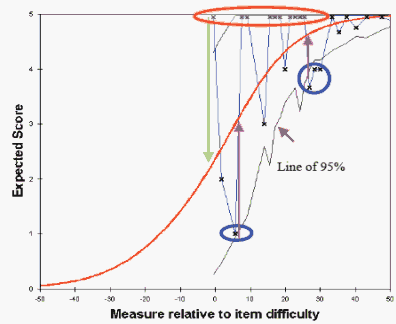
Item Characteristic Curves: Model and Empirical.
Figure 3 in Rashid et. al (2008) WSEAS Transactions on Advance in Engineering Education, 8, 5, 591-602
|
Infit Mean-squares: Mean ± 2 S.D.
"There are no hard-and-fast rules for setting upper- and lower-control limits for the infit statistics (i.e., infit mean-square index). In general, as Pollitt and Hutchinson (1987) suggest, any individual infit mean-square value needs to be interpreted against the mean and standard deviation of the set of infit-mean square values for the facet concerned. Using these criteria, a value lower than the mean minus twice the standard deviation would indicate too little variation, lack of independence, or overfit. A value greater than the mean plus twice the standard deviation would indicate too much unpredictability, or misfit." (Park, 2004)
Comment: This advice accords with an investigation into "Do the data fit the model usefully". The mean-squares are geometric with a range of 0-1-∞, which suggests that the computation of mean and standard deviation should be done using loge(mean-squares). In general, overfit (low mean-square) is generally a much smaller threat to the validity of the measures than excessive unpredictability (high mean-square).
Park, T. (2004) An investigation of an ESL placement test using Many-Facet Rasch Measurement. Teachers College, Columbia University Working Papers in TESOL and Applied Linguistics, 4, 1
journals.tc-library.org/index.php/tesol/article/view/41/48
Pollitt, A., & Hutchinson, C. (1987). Calibrated graded assessment: Rasch partial credit analysis of performance in writing. Language Testing, 4, 72-92.
Various (2009) Notes and Quotes, Rasch Measurement Transactions, 2009, 23:1, 1197
| Rasch Books and Publications |
|---|
| Invariant Measurement: Using Rasch Models in the Social, Behavioral, and Health Sciences, 2nd Edn. George Engelhard, Jr. & Jue Wang |
Applying the Rasch Model (Winsteps, Facets) 4th Ed., Bond, Yan, Heene |
Advances in Rasch Analyses in the Human Sciences (Winsteps, Facets) 1st Ed., Boone, Staver |
Advances in Applications of Rasch Measurement in Science Education, X. Liu & W. J. Boone |
Rasch Analysis in the Human Sciences (Winsteps) Boone, Staver, Yale |
| Introduction to Many-Facet Rasch Measurement (Facets), Thomas Eckes |
Statistical Analyses for Language Testers (Facets), Rita Green |
Invariant Measurement with Raters and Rating Scales: Rasch Models for Rater-Mediated Assessments (Facets), George Engelhard, Jr. & Stefanie Wind |
Aplicação do Modelo de Rasch (Português), de Bond, Trevor G., Fox, Christine M |
Appliquer le modèle de Rasch: Défis et pistes de solution (Winsteps) E. Dionne, S. Béland |
| Exploring Rating Scale Functioning for Survey Research (R, Facets), Stefanie Wind |
Rasch Measurement: Applications, Khine |
Winsteps Tutorials - free
Facets Tutorials - free |
Many-Facet Rasch Measurement (Facets) - free, J.M. Linacre |
Fairness, Justice and Language Assessment (Winsteps, Facets), McNamara, Knoch, Fan |
| Other Rasch-Related Resources: Rasch Measurement YouTube Channel |
|---|
Rasch Measurement Transactions &
Rasch Measurement research papers - free |
An Introduction to the Rasch Model with Examples in R (eRm, etc.), Debelak, Strobl, Zeigenfuse |
Rasch Measurement Theory Analysis in R, Wind, Hua |
Applying the Rasch Model in Social Sciences Using R, Lamprianou |
El modelo métrico de Rasch:
Fundamentación, implementación e interpretación de la medida en ciencias sociales (Spanish Edition),
Manuel González-Montesinos M. |
| Rasch Models: Foundations, Recent Developments, and Applications, Fischer & Molenaar |
Probabilistic Models for Some Intelligence and Attainment Tests, Georg Rasch |
Rasch Models for Measurement, David Andrich |
Constructing Measures, Mark Wilson |
Best Test Design - free, Wright & Stone
Rating Scale Analysis - free, Wright & Masters |
| Virtual Standard Setting: Setting Cut Scores, Charalambos Kollias |
Diseño de Mejores Pruebas - free, Spanish Best Test Design |
A Course in Rasch Measurement Theory, Andrich, Marais |
Rasch Models in Health, Christensen, Kreiner, Mesba |
Multivariate and Mixture Distribution Rasch Models, von Davier, Carstensen |
Go to Top of Page
Go to index of all Rasch Measurement Transactions
AERA members: Join the Rasch Measurement SIG and receive the printed version of RMT
Some back issues of RMT are available as bound volumes
Subscribe to Journal of Applied Measurement
Go to Institute for Objective Measurement Home Page.
The Rasch Measurement SIG (AERA) thanks the Institute for Objective Measurement for inviting the publication of Rasch Measurement Transactions on the Institute's website, www.rasch.org.
| Coming Rasch-related Events |
|---|
| Jan. 16 - Feb. 13, 2025, Fri.-Fri. | On-line workshop: Rasch Measurement - Core Topics (E. Smith, Winsteps), www.statistics.com |
| Apr. 8 - Apr. 11, 2026, Wed.-Sat. | National Council for Measurement in Education - Los Angeles, CA, ncme.org/events/2026-annual-meeting |
| Apr. 8 - Apr. 12, 2026, Wed.-Sun. | American Educational Research Association - Los Angeles, CA, www.aera.net/AERA2026 |
| May. 15 - June 12, 2026, Fri.-Fri. | On-line workshop: Rasch Measurement - Core Topics (E. Smith, Winsteps), www.statistics.com |
| June 19 - July 25, 2026, Fri.-Sat. | On-line workshop: Rasch Measurement - Further Topics (E. Smith, Winsteps), www.statistics.com |
The URL of this page is
www.rasch.org/rmt/rmt231l.htm
Website: www.rasch.org/rmt/contents.htm
